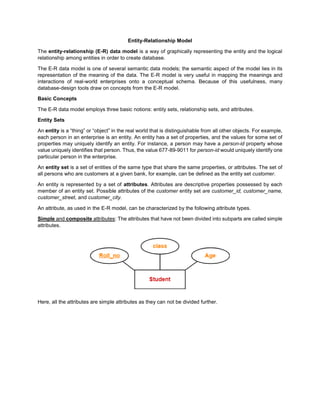
Entity Relationship Model
- 1. Entity-Relationship Model The entity-relationship (E-R) data model is a way of graphically representing the entity and the logical relationship among entities in order to create database. The E-R data model is one of several semantic data models; the semantic aspect of the model lies in its representation of the meaning of the data. The E-R model is very useful in mapping the meanings and interactions of real-world enterprises onto a conceptual schema. Because of this usefulness, many database-design tools draw on concepts from the E-R model. Basic Concepts The E-R data model employs three basic notions: entity sets, relationship sets, and attributes. Entity Sets An entity is a “thing” or “object” in the real world that is distinguishable from all other objects. For example, each person in an enterprise is an entity. An entity has a set of properties, and the values for some set of properties may uniquely identify an entity. For instance, a person may have a person-id property whose value uniquely identifies that person. Thus, the value 677-89-9011 for person-id would uniquely identify one particular person in the enterprise. An entity set is a set of entities of the same type that share the same properties, or attributes. The set of all persons who are customers at a given bank, for example, can be defined as the entity set customer. An entity is represented by a set of attributes. Attributes are descriptive properties possessed by each member of an entity set. Possible attributes of the customer entity set are customer_id, customer_name, customer_street, and customer_city. An attribute, as used in the E-R model, can be characterized by the following attribute types. Simple and composite attributes: The attributes that have not been divided into subparts are called simple attributes. Here, all the attributes are simple attributes as they can not be divided further.
- 2. Composite attributes, on the other hand, can be divided into subparts (that is, other attributes). Here, the attributes “Name” and “Address” are composite attributes as they are composed of many other simple attributes. Single-valued and multivalued attributes: Single valued attributes are those attributes which can take only one value for a given entity from an entity set. Here, all the attributes are single valued attributes as they can take only one specific value for each entity. Multi valued attributes are those attributes which can take more than one value for a given entity from an entity set. Here, the attributes “Mob_no” and “Email_id” are multi valued attributes as they can take more than one values for a given entity.
- 3. Derived attribute: The value for this type of attribute can be derived from the values of other related attributes or entities. Here, the attribute “Age” is a derived attribute as it can be derived from the attribute “DOB”. Key attributes: Key attributes are those attributes which can identify an entity uniquely in an entity set. Here, the attribute “Roll_no” is a key attribute as it can identify any student uniquely. Null attributes: An attribute takes a null value when an entity does not have a value for it. The null value may indicate “not applicable”—that is, that the value does not exist for the entity. For example, one may have no middle name. Null can also designate that an attribute value is unknown. An unknown value may be either missing (the value does exist, but we do not have that information) or not known (we do not know whether or not the value actually exists).